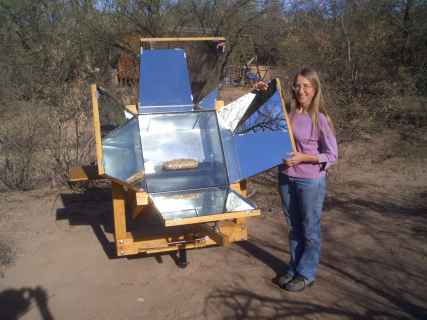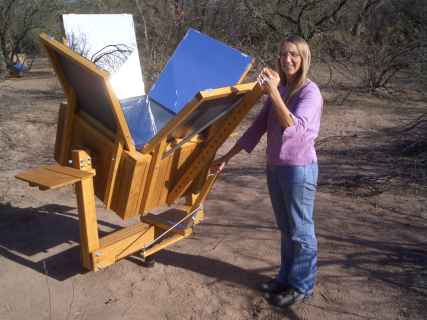

| Our Current Solar Oven (Updated 5/14/2016) For more information, see our other web pages on solar ovens:
|
| | |
| This is the first solar oven I've built since the Casa Juliana solar oven back in the 1990's. It is not as hot an oven, but does easily reach 400+ degrees F even in December. We find this temperature to be plenty high enough for nearly all cooking. When lower temperatures are desired, the oven is aimed somewhat away from the sun. Like the Casa Juliana oven, this one is very convenient to use. The oven can be aimed in seconds, cooking containers are always level regardless of oven angle, it has shelves on the yoke for setting cooking containers on and it's built to remain out in the weather. Unfortunately, it is also one of the few technologies on this website that is too complicated to be easily replicable. Although it is a very convenient oven to use, the design is sufficiently complex that constructing it is outside the scope of most home builders (see Simplicity vs. Complexity on the Design Page). Here are a few of the construction details: -The outer oven box measures 31" square by 16" high, constructed of 5/8" T-111 siding. -The inner oven box is 2' square by 13 1/2" deep, constructed of galvanized steel flashing. -The glazing is double pane tempered glass, 25" x 25" (1/8" glass, 1/2" air space, 3/4" total thickness). -The reflectors are 4 glass mirrors, each 1/8" thick and 2' square. -The food tray is 1/4"x10"x22" plate steel. -The yoke is built of 2"x6" and 2"x4" lumber. -The yoke is bolted to a piece of 1/4"x6"x6" plate steel, welded to one end of a 2" steel pipe about 36" long. The 2" pipe is inserted into a piece of 2 1/2" pipe about 30" long. All but about 2" of the 2 1/2" pipe is buried in the ground. 4 pieces of 3/8" steel bar are welded to the 2 1/2" pipe at right angles to stabilize the pipe in the ground. Regarding the use of double pane glass in solar ovens, if the air space between the panes is only 1/8" (as in the Casa Juliana oven), it seems to work fine. In this oven however, the air space is 1/2" and we discovered that as the oven heated, the expansion of that volume of air caused the glass panes to bow away from each other. This had the effect of pulling the glass away from the aluminum spacer between the panes. At the same time, the butyl caulk which cements the panes together around the edge, began to melt. The melted caulk then began to flow into the air space between the panes. The problem was solved by using a long, 1/8" bit to drill a hole through the wood framing and then through the aluminum spacer, taking care not to nick the glass. The hole permitted pressure in the air space between the panes to equalize with atmospheric air pressure. A piece of pipe cleaner was inserted into the hole to preventing small insects from entering the air space. The hole was drilled on the lower side of the glass to prevent rain water from entering. We now get a small amount of condensation between the panes, but that's preferable to having caulk between the panes. Below are some construction photos.
|
| 3/4" Thermax insulation installed
| Fiberglass insulation and first piece of sheet metal oven box installed
|
| Oven box finished and food tray installed
| Yoke and angle adjustment mechanism
|
| Rear of oven, showing door and shelves
| Door removed (door is set on shelf while food is put in oven)
|
| 2013
update: During the fall, winter and spring that we're in Arizona each year, this continues to be Pearl's cooking workhorse, used on a daily basis to cook most of the food we eat. Nonetheless, it's beginning to show its age and we're thinking of replacing it. The mirrors have lost some of their silvering around the lower edges and one mirror was cracked when a bird flew into it. Also, melting of the butyl caulk (described above) has allowed moisture and dirt to enter the space between the two panes of tempered glass. The inner oven box, which was made from steel flashing, has rusted through in several places.
| |||||
| 2016
update: By 2014 the oven described above had disintegrated to the point of becoming non-functional, so we decided to replace it. The new design addresses all the deficiencies we experienced in our previous oven. All wood, except the oven door handles has been replaced with aluminum. The mirrors are polished stainless steel and the caulk between the double pane glass is high-temperature silicone. The new oven should last the ages, but does have one significant drawback. Aluminum is a good conductor and our extensive use of it for the inner and outer oven boxes, as well as the oven door, causes considerable themal leakage. The highest temperatures this oven can reach is just under 300F, so it's used more like a slow cooker. We may evenutally try to build a themal break between the aluminum inner box and the outer box and top, but it's working well as is. It gets daily use for cooking beans, casseroles, soups, vegetables, reheating leftovers, etc. | |||||
| | ||||
| Home page |